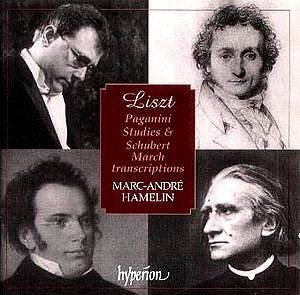There are two extremes of virtuosity. One might be
defined as the old-school furrow-browed, mane-tossing kind which deliberately
draws the attention of the public to the superhuman nature of the feats
being performed. This was the way of Paganini, to judge from contemporary
descriptions, of which a graphic one is provided in the excellent booklet
to this CD.
The other extreme might be summed up with reference
to a certain English organist who, from the privacy of his organ-loft,
was astounding his admirers with a performance of one of those Bach
pieces which seem to send hands and feet flying in all directions. Feeling
they must see the great man playing it, his fans crept up the
spiral stairs to risk a peep: their idol was engrossed in a motor magazine,
seemingly oblivious of his hands and feet flailing around him. This,
then, is the virtuosity which performs the great feats without looking
as if you are doing them.
Now I have no idea what Ignaz Friedman looked like
while he was playing, but his famous recording of "La Campanella",
the third of these Paganini Studies, seems to have "look at me"
written all over it. We are asked to gasp at the pianistic tight-rope
walking. Nor have I ever seen Marc-André Hamelin in action, but
the effect here is very much in the second category. You only have to
listen to him elegantly placing the acciaccaturas on the second page
to realise that the actual technical side has apparently vanished and
he can just play the music.
This does not make his performance any less astonishing
as a feat, indeed it is one of the finest Iíve heard, and I think that
in todayís world this is the right approach. For while plenty of us
would still long to play this music with ease, the fact is that it has
now been mastered by an alarming number of people and the feat Ė if
it just stopped at that Ė is therefore no longer so exceptional.
Iíve concentrated on "La Campanella" since
this is the one piece here which everybody will know. It is actually
the odd man out of the six studies since the others are all based on
one or more of Paganiniís Caprices, Liszt having been so bowled over
by the great violinistís playing that he wanted to create so pianistic
works which would be their equivalent in difficulty. These were his
first Studies for piano, to be followed by the Transcendental Studies
and the various Concert Studies.
The trouble with Paganini has always been that he might
have been a fantastic violinist but he was only a modest composer. With
the technical aspects so fully mastered by the pianist we are invited
to listen to these six pieces for their musical values which, in the
first study especially, are perhaps not all that great. But never mind,
Lisztís pianism ensures that most of the time our ear is beguiled in
one way or another and Hamelin is an unfailingly musical guide to it
all. No. 6, by the way, is the famous theme used by Rachmaninov and
many others.
Donít imagine from the title that the Schubert Marches
will be pretty little potboilers to round off the disc; Liszt has brought
together material from a number of Schubert Marches to create a large-scale
three-movement cycle of over 30 minutes which could very well be performed
in the second half of a recital and leave nobody feeling undernourished,
so varied are they in expression and pacing. It is interesting how Lisztís
love of Schubert usually lets the spirit of the original come through,
but from time to time he just has to let himself go. Hamelin understands
when to be Schubert and when to be Liszt and also keeps a just balance
between the two so the final effect is of a properly integrated work.
The real music on the disc lies here.
I was not so enthusiastic about Hamelinís Schumann
recital on Hyperion but he seems very well-suited to all the material
here. He has also recorded another Liszt anthology on Hyperion which
I havenít heard; if there are any plans for him to record one of the
big Schubert Sonatas, on the strength of his Liszt-Schubert I would
expect the results to be interesting.
Christopher Howell


